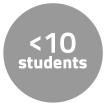Instructor Insights pages are part of the OCW Educator initiative, which seeks to enhance the value of OCW for educators.
Course Overview
This page focuses on the course 7.347 Epigenetic Regulation of Stem Cells as it was taught by Dr. Eric Williams and Dr. Vidya Subramanian in Spring 2014.
This course is one of many Advanced Undergraduate Seminars offered by the Biology Department at MIT. In these pass/fail seminars, students draw upon primary research literature to discuss and learn about current biological research in a highly interactive, small-group setting. This particular seminar focuses on the epigenetic regulation of stem cells.
Course Outcomes
Course Goals for Students
The main goal of this class is to give students the skills to critically analyze the primary scientific literature. By the end of the class the students should be able to analyze and evaluate papers in the field of epigenetics and stem cells. Furthermore, the students will acquire a basic understanding of the epigenetic and stem cell fields. Lastly the students will understand the basics of high throughput sequencing technology and know how to apply this technology to the study of epigenetics. The assignments provided also test their ability to think creatively and provide coherent ideas regarding answers to a specific question.
Curriculum Information
Prerequisites (recommended)
- 7.03 Genetics
- 7.05 General Biochemistry
- 7.06 Cell Biology
- 7.28 Molecular Biology
Requirements Satisfied
None
Offered
Seminars are offered each semester and are topics based. This particular topic is not offered every semester.
Below, Eric Williams and Vidya Subramanian describe various aspects of how they teach 7.347 Epigenetic Regulation of Stem Cells.
The main challenge associated with teaching this class is the development of the curriculum. We select foundation papers within the field of epigenetics and stem cells. The papers need to be written sufficiently well so that students can easily follow the methods. Papers with minimal methods, like those found in Nature Letters, are particularly difficult for students to read. In addition, papers that assume audience expertise and do not explain difficult techniques are also not appropriate for this class.
The papers need to be written in such a way that students with diverse backgrounds can understand and follow the papers. To address this challenge, we provide a simple description of the key techniques used in the papers the week before students are assigned to read them. This allows the students to familiarize themselves with the classical techniques that are recurrently used in the field.
Assessment
The class is graded on a pass/fail basis, and grades are based on participation in discussion every week, satisfactory completion of the written and oral assignments, and attendance.
Students are assessed based on their analysis of figures during class. In addition, they receive an assignment in which they are given a fictional abstract. The students create experiments that would lead to the results as stated in the abstract. They are assessed on feasibility and importantly, the inclusion of appropriate controls for their fictional experiments. As a final assignment the students choose a paper from the literature and prepare a presentation. The presentation includes a synopsis of the experiments and results. Students are encouraged to identify overstated claims, missing controls, and alternative explanations.
Student Information

Breakdown by Year
Students are in their junior or senior year of college.
Breakdown by Major
Students have a diverse academic background (math, chemical engineering, biology).
Ideal Class Size
Class size is limited to 8, to enable a high degree of personal contact with the instructor.
During an average week, students were expected to spend 6 hours on the course, roughly divided as follows:
Seminar Meeting
- Met once per week for 2 hours per session; 14 sessions total.
- The format of each class was the same. We start by discussing the hypothesis the authors were addressing, and the claims they were making.
- The students would then take turns leading discussions on each figure. The students would discuss missing controls, alternative explanations, and what is acceptable in terms of stated results.
- We would compare our results to the authors’ claims and determine if the claims had been overstated.
Out of Class
- Reading assignments – two journal articles per week
- Written Assignment
- Oral Presentation
Semester Breakdown
| WEEK | M | T | W | Th | F |
|---|---|---|---|---|---|
| 1 |  |  |  |  |  |
| 2 |  |  |  |  |  |
| 3 |  |  |  |  |  |
| 4 |  |  |  |  |  |
| 5 |  |  |  |  |  |
| 6 |  |  |  |  |  |
| 7 |  |  |  |  |  |
| 8 |  |  |  |  |  |
| 9 |  |  |  |  |  |
| 10 |  |  |  |  |  |
| 11 |  |  |  |  |  |
| 12 |  |  |  |  |  |
| 13 |  |  |  |  |  |
| 14 |  |  |  |  |  |
| 15 |  |  |  |  |  |
| 16 |  |  |  |  |  |
 No classes throughout MIT
No classes throughout MIT Seminar session
Seminar session Assignment due date
Assignment due date No class session scheduled
No class session scheduled Exam
Exam